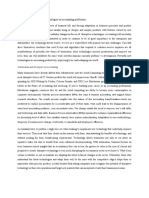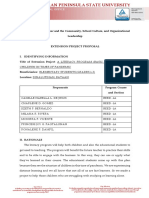0 ratings0% found this document useful (0 votes)
13 viewsDevelopment During Adolescence
Development During Adolescence
Uploaded by
Sheeraz Shaikhn,n lkj ljk jl
Copyright:
© All Rights Reserved
Available Formats
Download as PPT, PDF, TXT or read online from Scribd
Development During Adolescence
Development During Adolescence
Uploaded by
Sheeraz Shaikh0 ratings0% found this document useful (0 votes)
13 views38 pagesn,n lkj ljk jl
Original Title
development during Adolescence
Copyright
© © All Rights Reserved
Available Formats
PPT, PDF, TXT or read online from Scribd
Share this document
Did you find this document useful?
Is this content inappropriate?
n,n lkj ljk jl
Copyright:
© All Rights Reserved
Available Formats
Download as PPT, PDF, TXT or read online from Scribd
Download as ppt, pdf, or txt
0 ratings0% found this document useful (0 votes)
13 views38 pagesDevelopment During Adolescence
Development During Adolescence
Uploaded by
Sheeraz Shaikhn,n lkj ljk jl
Copyright:
© All Rights Reserved
Available Formats
Download as PPT, PDF, TXT or read online from Scribd
Download as ppt, pdf, or txt
You are on page 1of 38
Adolescents!!!
What is
adolescence?
• Not a disease or disorder!!!
• Time period – roughly the second decade of life
• It is a biological and cultural phenomenon experienced
differently across time and culture.
• Adolescence ≠ Puberty
Adolescence (from Latin adolescere, meaning
'to grow up') is a transitional stage of physical
and psychological development that generally
occurs during the period from puberty to legal
adulthood.
Critical Tasks of
Adolescence
• Development of adult body
• Attain sexual maturity
• Acquire mature thinking and planning
• Identity development
• Personal
• Sexual
• Vocational
• Moral
Adolescence is viewed as a transitional period between childhood
and adulthood, whose cultural purpose is the preparation of children
for adult roles. It is a period of multiple transitions involving
education, training, employment and unemployment, as well as
transitions from one living circumstance to another.
What is particular about
Adolescence?
Adolescence can be defined biologically, as the
physical transition marked by the onset of
puberty and the termination of physical growth;
cognitively, as changes in the ability to think
abstractly and multi-dimensionally; or socially, as
a period of preparation for adult roles. Major
pubertal and biological changes include changes
to the sex organs, height, weight, and muscle
mass, as well as major changes in brain structure
and organization. Cognitive advances encompass
both increment in knowledge and in the ability to
think abstractly and to reason more effectively.
Puberty involves…
• Growth spurt
• Weight gain
• Adult body composition
• Secondary sexual development
(breasts, pubic hair, genital
development)
• Menstrual periods and sexual maturity
Normal Pubertal
Development
Characteristic Age
Range
Breast development begins
8-13 years
Breast development complete
12-18 years
Pubic hair appears
8-14 years
Growth spurt begins
9-14 years
Menarche
10-16 years
Biological
Development:
Puberty
Puberty is a period of several years in which
rapid physical growth and psychological
changes occur, culminating in sexual maturity.
The average age of onset of puberty is at 11
for girls and 12 for boys. Every person's
individual timetable for puberty is influenced
primarily by heredity, although environmental
factors, such as diet and exercise, also exert
some influences. These factors can also
contribute to precocious and delayed puberty.
Hormonal Activity:
Puberty
Puberty occurs through a long process and begins
with a surge in hormone production, which in turn
causes a number of physical changes. It is the
stage of life characterized by the appearance and
development of secondary sex characteristics (for
example, a deeper voice and larger adam's
apple in boys, and development of breasts and
more curved and prominent hips in girls) and a
strong shift in hormonal balance towards an adult
state. This is triggered by the pituitary gland,
which secretes a surge of hormonal agents into the
blood stream, initiating a chain reaction to occur.
Landmark in Puberty
The major landmark of puberty for males is spermarche,
the first ejaculation, which occurs, on average, at age
13. For females, it is menarche, the onset of
menstruation, which occurs, on average, between ages 12
and 13. The age of menarche is influenced by heredity,
but a girl's diet and lifestyle contribute as well. Regardless
of genes, a girl must have a certain proportion of body fat
to attain menarche. Consequently, girls who have a high-
fat diet and who are not physically active begin
menstruating earlier, on average, than girls whose diet
contains less fat and whose activities involve fat reducing
exercise. Girls who experience malnutrition or are in
societies in which children are expected to perform
physical labor also begin menstruating at later ages.
Pubescent Boys:
Positives &
Negatives
The timing of puberty can have important psychological and social
consequences. Early maturing boys are usually taller and stronger than
their friends. They have the advantage in capturing the attention of
potential partners and in becoming hand-picked for sports. Pubescent
boys often tend to have a good body image, are more confident,
secure, and more independent. Late maturing boys can be less
confident because of poor body image when comparing themselves to
already developed friends and peers. However, early puberty is not
always positive for boys; early sexual maturation in boys can be
accompanied by increased aggressiveness due to the surge of
hormones that affect them. Because they appear older than their
peers, pubescent boys may face increased social pressure to conform
to adult norms; society may view them as more emotionally advanced,
despite the fact that their cognitive and social development may lag
behind their appearance. Studies have shown that early maturing boys
are more likely to be sexually active and are more likely to participate
in risky behaviors.
Pubescent Girls:
Positives &
Negatives
For girls, early maturation can sometimes lead to increased
self-consciousness, though a typical aspect in maturing
females. Because of their bodies' developing in advance,
pubescent girls can become more insecure and
dependent. Consequently, girls that reach sexual maturation
early are more likely than their peers to develop eating
disorders (such as anorexia nervosa).
Girls have usually reached full physical development by ages
15–17, while boys usually complete puberty by ages 16–
17. Any increase in height beyond the post-pubertal age is
uncommon. Girls attain reproductive maturity about four
years after the first physical changes of puberty appear. In
contrast, boys accelerate more slowly but continue to grow
for about six years after the first visible pubertal changes.
Developmental
Stages of
Adolescence
• Early Adolescence: 11-14 years
• Middle Adolescence: 14-17 years
• Late Adolescence: 18-21 years
Growth Spurt
The adolescent growth spurt is a rapid increase in the
individual's height and weight during puberty resulting from
the simultaneous release of growth hormones, thyroid
hormones, and androgens. Males experience their growth
spurt about two years later, on average, than females.
During their peak height velocity (the time of most rapid
growth), adolescents grow at a growth rate nearly identical
to that of a toddler—about 4 inches (10.3 cm) a year for
males and 3.5 inches (9 cm) for females. In addition to
changes in height, adolescents also experience a significant
increase in weight. The weight gained during adolescence
constitutes nearly half of one's adult body weight.
Growth Pattern
The significant physical changes during puberty happen
in bodily distribution of fat and muscle. This process is
different for females and males. Before puberty, there
are nearly no sex differences in fat and muscle
distribution; during puberty, boys grow muscle much
faster than girls, although both sexes experience rapid
muscle development. In contrast, though both sexes
experience an increase in body fat, the increase is much
more significant for girls. Frequently, the increase in fat
for girls happens in their years just before puberty. The
ratio between muscle and fat among post-pubertal boys
is around three to one, while for girls it is about five to
four. This may help explain sex differences in athletic
performance.
Growth Pattern
The accelerated growth in different body parts
happens at different times, but for all adolescents it
has a fairly regular sequence. The first places to
grow are the extremities—the head, hands and feet
—followed by the arms and legs, then the torso and
shoulders. This non-uniform growth is one reason
why an adolescent body may seem out of
proportion.
During puberty, bones become harder and more
brittle. At the conclusion of puberty, the ends of the
long bones close during the process
called epiphysis
Pubertal
Development
Pubertal development also affects circulatory and
respiratory systems as an adolescents' heart and
lungs increase in both size and capacity. These
changes lead to increased strength and tolerance
for exercise. Sex differences are apparent as
males tend to develop "larger hearts and lungs,
higher systolic blood pressure, a lower resting
heart rate, a greater capacity for carrying oxygen
to the blood, a greater power for neutralizing the
chemical products of muscular exercise, higher
blood hemoglobin and more red blood cells".
Changes in the
brain
The human brain is not fully developed by the
time a person reaches puberty. Between the ages
of 10 and 25, the brain undergoes changes that
have important implications for behavior. The
brain reaches 90% of its adult size by the time a
person is six years of age. Thus, the brain does
not grow in size much during adolescence.
However, the creases in the brain continue to
become more complex until the late teens. The
biggest changes in the folds of the brain during
this time occur in the parts of the cortex that
process cognitive and emotional information.
Early Adolescence
Cognitive Development
• Concrete thinking – or – in the “here and now”
• Difficulty reflecting on others’ points of view
• Extreme concern with own needs, and
assumption that these needs are equally
important to others!!!
• Tendency to magnify one’s personal situation
Early Adolescence
Cognitive Development
• “Imaginary Audience” – always on stage
• Frequent daydreaming
• Greater need for privacy – writing in diaries, etc.
• “Personal Fable” – no one knows what it’s like to
be me…
• Sense of invulnerability
• Inability to perceive long-range implications of
current decisions and actions
• LACK OF IMPULSE CONTROL
Early Adolescence
Psychosocial Development
• Rapid physical changes lead to preoccupation
with physical appearance and changes in body.
• Seek constant reassurance of their own
normalcy.
• AM I NORMAL?
• Increased interest in sexual anatomy and
physiology:
• Periods, nocturnal emissions, masturbation, breast
and penis size
• Attractiveness
Early Adolescence
Psychosocial Development
• Begin separation from parents.
• Exploration and definition of independence-
dependence boundaries.
• Less interest in parent/family activities
• Reluctance to tacitly accept parental advice
• Realizes the parent isn’t perfect!!!
Early Adolescence
Psychosocial Development
• Importance of peer group and conformity
with peers increases.
• Search for new people to love in addition to
parents.
• Intense, idealized same-sex relationships
common (BFF)
• Limited capacity for intimacy given cognitive
constraints.
Early Adolescence
Psychosocial Development
• Wide mood and behavior swings.
• Erratic movement into and out of childhood
world.
• Childish coping skills ineffective in adult
situations.
Middle Adolescence
Cognitive Development
• Begin the gradual realization that others have
needs of their own.
• Idealism and commitment to social causes
common.
• Further ability to use abstract thinking, but
inconsistently applied.
• May revert to more concrete levels at times of
stress.
• May lead to inconsistent or “irrational” behavior.
• Persistence of sense of immortality.
Middle Adolescence
Psychosocial Development
• Increase in intensity of emotions
• Peak of child-parent control battles.
• Able to conceive of “ideal” parents,
contrast with own parents.
• Intermittent seeking and rejection of
parental support.
Middle Adolescence
Psychosocial Development
• Peer group becomes primary means of
social support, buffering the separation
process.
• Peers are “everybody” and define
“everything”.
• Peer group allows forum for testing new
identities.
• Role experimentation, limit-testing, risk-
taking fostered by persistent sense of
invulnerability.
Middle Adolescence
Psychosocial Development
• Re-establishment of body image.
• Strong emphasis on being attractive.
• (Clothes, makeup)
• Increasing sexual interest, curiosity,
experimentation, partnerships.
Late Adolescence
Cognitive Development
• Improved sense of time and the future.
• Ability to assess the long-term
consequences or benefits of actions.
• More able to think ideas through and
express herself in words.
• Greater ability to delay gratification.
Late Adolescence
Psychosocial Development
• Acceptance of body image.
• Consolidation of personal identity .
• Further steps toward emancipation.
• Practical vocational goals
• Beginnings of financial independence
• Re-establishment of relationship with
parents (“adult-adult” interaction).
Late Adolescence
Psychosocial Development
• Decreased need for peer affiliation.
• Increased emphasis placed on individual
friendships.
• Increased capacity for intimacy and
movement toward more stable
relationships.
Decline in Self
Esteem
• The transition into adolescence is
challenging for many.
• Many girls experience a precipitous
decline in self-confidence and self-
esteem by the age of 12, whereas boys
self-esteem increases with age.
Decline in Self-Esteem
• Low self-esteem has been linked to:
• Impaired academic performance
• Mood problems such as depression
• Early alcohol and substance use
• Dieting and disordered eating
• Early sexual activity
• Decreased interest in math and science
Relational Aggression
• Relational aggression is more common among late
elementary and junior high age boys and girls
• What is it?
• Dirty looks, spreading rumors, social isolation or
exclusion, mean jokes, cyber-bullying
• Girls are skilled in navigating relationships.
• Relationships are very important to girls.
• Girls get mixed messages about what kind of
behavior is “ideal”. They are expected to be
passive and powerful at the same time.
Relational
Aggression
• The line between bully and victim is often
blurred, and roles are frequently reversed.
• This behavior is often invisible to adults.
• Youth involved with bullying are at risk for:
• Health problems
• Depression and suicidal ideation
• Alcohol use
• Poor school achievement
Nutrition Challenges
• As girls enter adolescence, they become very focused on
physical appearance and attractiveness.
• Girls are avid consumers of the media, and are
bombarded with re-touched, unrealistic, sexualized
images of females.
• The average % body fat of an actress is 10% lower
than that of a healthy woman.
• Consequently, it is no surprise that girls are more likely
than boys to perceive themselves as overweight.
• Girls are likely to think they need to lose weight, even
when they are at a healthy weight.
• Girls often equate thinness with happiness
Nutrition Challenges
• Troublesome decline in dairy and
nutrient consumption
• Increased consumption of unhealthy
foods
• Unfortunately, overweight adolescents
are very likely to become overweight
adults.
Other Pitfalls
• Girls become more sedentary as they
enter adolescence.
• Adolescent girls are more than twice as
likely as boys to experience
depression, and more likely to attempt
suicide.
Parents – The Answer
• The importance of parents cannot be
overstated!!!
• Strong parental support helps provide
teenagers a firm foundation as they
enter adolescence.
• Parental monitoring and supervision
decrease youth involvement in many
high-risk behaviors.
• Adolescents want and need parents,
and other adults who care, in their lives.
You might also like
- Steinberg - S AdolescentsDocument111 pagesSteinberg - S Adolescents98g2gymhw8No ratings yet
- High SchoolerDocument67 pagesHigh SchoolerJulie Ann Gines100% (2)
- NUTR 323 Chapter 14 NotesDocument27 pagesNUTR 323 Chapter 14 NotesMon LuffyNo ratings yet
- Ark AngelDocument172 pagesArk AngelCrina Serban67% (6)
- Group 3 ResearchDocument56 pagesGroup 3 ResearchTirsolito Salvador67% (3)
- Adolescent Stage: Presented by Group 5Document23 pagesAdolescent Stage: Presented by Group 5Fatima Ayela JamalulNo ratings yet
- Adolesecent AgeDocument42 pagesAdolesecent Agecyrilsarmiento9100% (1)
- Psycological DevelopmentDocument3 pagesPsycological DevelopmentShafeeu MuhammadNo ratings yet
- Child and Adolscent ReportDocument20 pagesChild and Adolscent ReportAlie MandiNo ratings yet
- MSW - Adolescent DevelopmentDocument11 pagesMSW - Adolescent DevelopmentbinuscariasdbNo ratings yet
- Physical/Biological Changes in Human Growth: Group 1Document13 pagesPhysical/Biological Changes in Human Growth: Group 1Ariessa Delos Santos100% (1)
- Developmental PsychologyDocument4 pagesDevelopmental PsychologyWidadNo ratings yet
- Adolescence Stage of DevelopmentDocument9 pagesAdolescence Stage of DevelopmentShannie PadillaNo ratings yet
- Physical Development of High School LearnersDocument27 pagesPhysical Development of High School LearnersyoonglespianoNo ratings yet
- Growth and Development LectureDocument4 pagesGrowth and Development Lecturechristinejoyaberin05No ratings yet
- Characteristics of Adolescence08Document82 pagesCharacteristics of Adolescence08Frances Daloraya100% (1)
- Unit 1. Personality DevelopmentDocument6 pagesUnit 1. Personality DevelopmentKarthi Keyan VeeraNo ratings yet
- I Am Sharing 'LECTURE 10 - ADOLESCENTS COGNITIVE AND PHYSICAL DEVELOPMENTDocument32 pagesI Am Sharing 'LECTURE 10 - ADOLESCENTS COGNITIVE AND PHYSICAL DEVELOPMENTmarthandeufiilwaNo ratings yet
- 1 PubertyDocument15 pages1 PubertyNandha KumarNo ratings yet
- Human Growth and DevelopementDocument4 pagesHuman Growth and Developementhrithik0717No ratings yet
- AdolescenceDocument10 pagesAdolescencePhillip NelsonNo ratings yet
- Unit 1Document6 pagesUnit 1Vinayak PlNo ratings yet
- Adolescent Reproductive and Sexual HealthDocument49 pagesAdolescent Reproductive and Sexual Healthmuhamadzakir22355No ratings yet
- Physical Development of High School LearnersDocument49 pagesPhysical Development of High School LearnersDiana Garcia SaclutiNo ratings yet
- PGDT 412 Unt 1 To 3Document38 pagesPGDT 412 Unt 1 To 3Belete Argachew100% (2)
- Adolescence (The High School Learner)Document28 pagesAdolescence (The High School Learner)KD AlquizarNo ratings yet
- Chapter 11 NotesDocument4 pagesChapter 11 Notesdoodle every dayNo ratings yet
- Psychology Internals ContentDocument23 pagesPsychology Internals ContentMohit KapseNo ratings yet
- RESEARCHDocument16 pagesRESEARCHIvonette LabangNo ratings yet
- Chapter X - Puberty and AdloscenceDocument54 pagesChapter X - Puberty and AdloscencehitoNo ratings yet
- PubertyDocument19 pagesPubertyzest2 koteshworNo ratings yet
- 10 Adolescence (A) HalfDocument14 pages10 Adolescence (A) HalfSyeda Umme JavariaNo ratings yet
- AdolescenceDocument12 pagesAdolescenceTrishaYsobelleMedianteMorales100% (1)
- Module - 24 Physical Development of High School LearnersDocument14 pagesModule - 24 Physical Development of High School LearnersArabelle PazNo ratings yet
- The Nature of AdolescenceDocument42 pagesThe Nature of Adolescencealtheaatienza0906No ratings yet
- Adolescent Development Unit 1 Exam! Questions & AnswersDocument28 pagesAdolescent Development Unit 1 Exam! Questions & AnswersfelixkaharaNo ratings yet
- Adolescence Is Transitional Phase of GrowthDocument7 pagesAdolescence Is Transitional Phase of GrowthZahra SaleemNo ratings yet
- Child D JournalDocument22 pagesChild D JournalSachin SinghNo ratings yet
- Devpsych 8 1oDocument19 pagesDevpsych 8 1o[PEA] Kissaneth MalasibasNo ratings yet
- Adolescent Reproductive and Sexual HealthDocument42 pagesAdolescent Reproductive and Sexual HealthMuhammad Abbas WaliNo ratings yet
- IV. Physical Self PPT - PDF (Acquire)Document50 pagesIV. Physical Self PPT - PDF (Acquire)Ghillian Mae GuiangNo ratings yet
- Development Task Summary Puberty Is The Starting Point of Adolescence and Is Associated With A Great Variety of SomaticDocument1 pageDevelopment Task Summary Puberty Is The Starting Point of Adolescence and Is Associated With A Great Variety of SomaticJenu Chemie IriganNo ratings yet
- Review of LiteratureDocument51 pagesReview of Literaturenawahib aliNo ratings yet
- Growth and Developmet of Adolescence: by Sajith.SDocument47 pagesGrowth and Developmet of Adolescence: by Sajith.SSajith Kanjiraikal0% (1)
- Health Promotion of The Adolescence and FamilyDocument21 pagesHealth Promotion of The Adolescence and FamilyNurul IstiqomahNo ratings yet
- 10: Physical Development: Student ObjectivesDocument9 pages10: Physical Development: Student ObjectivesŞterbeţ RuxandraNo ratings yet
- DP II NotesDocument37 pagesDP II NotesNamithaNo ratings yet
- AdolescenceDocument2 pagesAdolescenceMarrian Bonifacio GamboaNo ratings yet
- Module 9 Adolescence Physical Cognitive and Socioemotional DevelopmentDocument23 pagesModule 9 Adolescence Physical Cognitive and Socioemotional DevelopmenttopakinNo ratings yet
- Final ResearchDocument29 pagesFinal ResearchCamille C. MalazaNo ratings yet
- Physical Self (Understanding The Self)Document10 pagesPhysical Self (Understanding The Self)Princes Jhoy Garay BatanesNo ratings yet
- MAPEH L3 - Physical Changes During Puberty MAPEH 5Document13 pagesMAPEH L3 - Physical Changes During Puberty MAPEH 5Chester ManalangNo ratings yet
- 09 - Chapter 1Document33 pages09 - Chapter 1Joma Pauline EmbestroNo ratings yet
- PUBERTYDocument55 pagesPUBERTYFrancee Nicole PangilinanNo ratings yet
- Understanding The Physical Changes of Puberty: Maria R. de Guzman, Extension Adolescent SpecialistDocument2 pagesUnderstanding The Physical Changes of Puberty: Maria R. de Guzman, Extension Adolescent SpecialistBrett DawsonNo ratings yet
- Life Span Psy AssignmentDocument6 pagesLife Span Psy AssignmentNEHA JUNEJANo ratings yet
- Report NCM AdolescentsDocument41 pagesReport NCM AdolescentsDenise EspinosaNo ratings yet
- Notes - Week 11 - Adolescent-Physical DevelopmentDocument33 pagesNotes - Week 11 - Adolescent-Physical DevelopmentSyuhadaNo ratings yet
- Junaid AnwarDocument10 pagesJunaid Anwarcofini2389No ratings yet
- Puberty: A Guide For Teenage Boys And Their ParentsFrom EverandPuberty: A Guide For Teenage Boys And Their ParentsNo ratings yet
- Ontogenesis of Man: From Conception to Adulthood and to His Final DestinationFrom EverandOntogenesis of Man: From Conception to Adulthood and to His Final DestinationNo ratings yet
- Understanding Child Development: A Comprehensive GuideFrom EverandUnderstanding Child Development: A Comprehensive GuideNo ratings yet
- BlankDocument2 pagesBlankclint xavier odangoNo ratings yet
- The Impact of Disruptive Technologies On Accounting Profession 01Document2 pagesThe Impact of Disruptive Technologies On Accounting Profession 01Rashìd RanaNo ratings yet
- P3 3B Gutierrez JohnPaulDocument4 pagesP3 3B Gutierrez JohnPauljp gutierrezNo ratings yet
- Africa Barometer: NamibiaDocument48 pagesAfrica Barometer: NamibiaAlice YangNo ratings yet
- Liminal It 1Document3 pagesLiminal It 1Kit DiazNo ratings yet
- Creating and Weighting Hunspell Dictionaries As FiDocument17 pagesCreating and Weighting Hunspell Dictionaries As FiAvraham ZentliNo ratings yet
- Immediate download On Freud s Formulations on the Two Principles of Mental Functioning The International Psychoanalytical Association Contemporary Freud Turning Points and Critical Issues Series 1st Edition Gabriela Legorreta ebooks 2024Document40 pagesImmediate download On Freud s Formulations on the Two Principles of Mental Functioning The International Psychoanalytical Association Contemporary Freud Turning Points and Critical Issues Series 1st Edition Gabriela Legorreta ebooks 2024nambadeluz57100% (3)
- List of Ratnam Mill Stores in Vizianagaram - Pythondeals2Document4 pagesList of Ratnam Mill Stores in Vizianagaram - Pythondeals2SRINIVASARAO JONNALANo ratings yet
- Sangh Parivar: History PhilosophyDocument5 pagesSangh Parivar: History Philosophyfaiz1108No ratings yet
- Class - IX Prose 1 The Sound of MusicDocument2 pagesClass - IX Prose 1 The Sound of MusicNeetu JainNo ratings yet
- Tarzi Manar-ResumeDocument2 pagesTarzi Manar-Resumeapi-483676186No ratings yet
- Central Office: Capitol Compound, Tenejero, City of Balanga 2100 BataanDocument6 pagesCentral Office: Capitol Compound, Tenejero, City of Balanga 2100 BataanPrincess Joy G. PagtalunanNo ratings yet
- A Sample Project Work On Attitude: Results and InterpretationDocument5 pagesA Sample Project Work On Attitude: Results and InterpretationRinto RobertNo ratings yet
- 0 PRO Sigma 688 ENDocument12 pages0 PRO Sigma 688 ENayoub ramziNo ratings yet
- Medical Schools Directory June2021Document4 pagesMedical Schools Directory June2021ethan emmanuel clintonNo ratings yet
- Transcutaneous Serdev Suture Suspensions For Lifting or Volume Augmentation in Face and BodyDocument6 pagesTranscutaneous Serdev Suture Suspensions For Lifting or Volume Augmentation in Face and BodyDoctores Duarte BarrosNo ratings yet
- Move Up 4 - U9 - Lesson 1Document40 pagesMove Up 4 - U9 - Lesson 1Am LaNo ratings yet
- Welcome To The Lecture On Introduction To Lathe Machine: Rajshahi University of Engineering & TechnologyDocument44 pagesWelcome To The Lecture On Introduction To Lathe Machine: Rajshahi University of Engineering & TechnologyFaysal AhmedNo ratings yet
- Types of Sentences - Answer KeyDocument3 pagesTypes of Sentences - Answer KeyMaiElGebaliNo ratings yet
- DNB Thesis GuidelinesDocument7 pagesDNB Thesis Guidelinesjuliasolembellevue100% (3)
- Bros and ConsDocument25 pagesBros and ConsHarrisonFordFocusNo ratings yet
- Jobs and OccupationsDocument58 pagesJobs and OccupationsrubebpopsNo ratings yet
- Cae - FlyersDocument40 pagesCae - Flyersnaseemara19882022No ratings yet
- D R. R. Rajes H: ST THDocument8 pagesD R. R. Rajes H: ST THR. RajeshNo ratings yet
- LogcatDocument210 pagesLogcatPriyatanu Bazinga DeyNo ratings yet
- Wipro Oracle R12 White Paper 2111Document10 pagesWipro Oracle R12 White Paper 2111rajkumarNo ratings yet
- Calculation of Rotor Interference in Screw CompresDocument9 pagesCalculation of Rotor Interference in Screw CompresAdrian SetyadharmaNo ratings yet
- Chapter 2 Thesis Format PDFDocument4 pagesChapter 2 Thesis Format PDFchristinabergercolumbia100% (2)

























































































